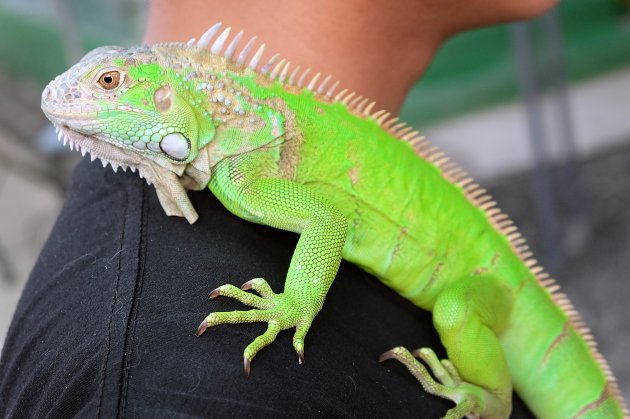The iguana as a pet
is becoming more and more popular. However, before adopting it, you must know all its morphology and type of life.Some buyers buy it for the bright green color of young animals and because of its size close to 50 cm.
- But over time they can reach 1.
- 80 meters.
- A considerable size that will be difficult to maintain if you have a small floor.
- Want to know more about this fantastic animal that is the iguana? Discover all about iguanas and find out if it’s the perfect animal for you in this Animal Expert article.
The iguana is an Aboriginal reptile. When young, it has a very attractive bright green color, which turns pale gray as it becomes an adult. You always live near the water and when you feel insecure do not hesitate to go there, because it does nothing very well.
Like geckos and other reptiles, the iguana has the ability to produce autonomy, meaning it is able to drop the tail if it feels threatened to attract the pebble and escape. Then the tail regenerates and grows back, however, it will never make it as big and beautiful as the original. Besides, if you lose it again, it won’t grow back.
The iguana lives from the coast of Mexico to South America and lives for about 13 years.
To acclimatize the iguana to your home, you must mainly recreate all the ideal temperature and humidity conditions for the survival of the animal, knowing that the 50 cm that the iguana will have when it is adopted quickly will become 1.80 meters.
Before you buy the iguana, ask yourself if he and his family have enough space to live together. Your children will also grow up and need more space as they grow up. Rate all of this before you buy.
The minimum dimensions of the terrarium for your adult iguana must be at least 150x160x75 cm, taking into account that the height is more important than the width of the terrarium, because inside you have to place a trunk with branches for the animal to climb.
The temperature inside the terrarium should vary between 28 and 32 degrees Celsius. During the night, when the animal is inactive, the temperature can drop to 25 degrees Celsius.
At the bottom of the terrarium can be placed a layer of gravel of about 11-15 cm, below which all the cables will pass: that of the radiator, the fluorescent light 0.5 UBV, so that the iguana correctly summarizes vitamin D.
Humidity should range from 70 to 85% and in addition to the drinker, where you have to change the water daily, it is convenient to have a wide and shallow container to swim.
In addition to the trunk, you can place flat, borderless stones and some non-toxic plants to decorate the terrarium.
When the iguana is young, it eats more often than when it is an adult. In addition to insects, it eats fruits, vegetables, leaves and plants.
The frequency with which we have to feed it is 3 times a week, preferably in the afternoon or in the morning. When he reaches adulthood, he eats less often. Adult iguanas are herbivores. Your veterinarian will tell you the right amounts of food for your iguana.
Your iguana should always be checked by the veterinarian. In the event of a color change, the fact that the shine of your skin fades or any other changes, you should consult your veterinarian to evaluate the change and rule out some of the most common diseases of iguanas.
Vitamin supplements may need to be administered, always prescribed by the veterinarian.The veterinarian should also cut his nails periodically so that the claws do not twist.
You should avoid sudden air currents and drops in temperature, as the iguana may suffer respiratory infections from pathogens.
If you see white spots developing on the skin of your iguana, it’s a sign that mites colonize your iguana’s skin.You should bathe it with warm water, then carefully clean the terrarium.
Iguanas can have ticks, you can remove them with tweezers
To interact properly with your iguana, the first thing you need to do is learn how to pick it up correctly. Never take your iguana by the tail, as it can come out very easily.
You must gently grab it by the belly by the hind legs. Watch the iguana react, if you try to hit your tail like a whip or if you open your mouth aggressively, you don’t want to be disturbed.
One thing you need to do to help you interact with your iguana is to let her walk out of the terrarium for an hour a day, always under your supervision.
Have you recently adopted any of these animals? See our article with the names of the green iguana!
If you would like to read articles similar to, we recommend that you visit our What You Need to Know section.

